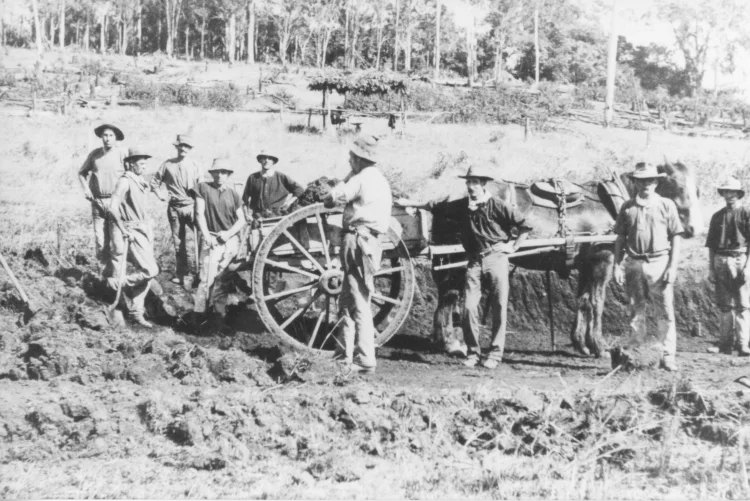WE’VE COME A LONG WAY
We’ve come a long way
Mary Valley Timbers is located in the Mary Valley hinterland which has a rich history in the timber industry. Our historic sawmill has passed through different hands in the community over the years dating back to the mid 1900’s. The mill was built in the 1920’s by the late Jack Orms as proprietor, and his brother-in-law Billy Kidd as his off sider. Fast forward to 1988 where the Dagun sawmill was taken over by Wayne and Kaye Morris and their friends Ken and Maree Walker. Daily operations at the sawmill are now managed by Wayne’s daughter and son-in-law Sara and Tom Hooper and partners Jason & Annika File.
Mary Valley Timbers first began operations by sending sleepers and posts back down to Melbourne and now, with two green mills, including a newly commissioned mill, a dressing shed and a multipurpose timber yard, we proudly service the needs of builders here at home, and abroad.
Using wood as a primary building material has many benefits for the environment.
In 2017 the Gympie Regional Council became the second Queensland municipality to adopt a Wood Encouragement Policy (WEP), which aims to drive the use of timber products in local building and construction projects. Today more than 20 other jurisdictions nationwide have adopted this same policy.
Responsibly sourced, certified timber can provide our customers with assurance that the timber is sourced from forests that meet the requirements for Sustainable Forest Management under the Australian Standard.
Servicing Gympie and the Mary Valley, all the way out to Noosa, Cooroy and the Sunshine Coast, as well as our regular customer base, our longstanding industry knowledge allows us to provide our customers with priceless advice for all their hardwood, pine and hardware needs.
You see, we’re passionate about our industry, our community and our customers. We know you’ll feel that after speaking to our fantastic staff about any project or job you’ve got on the boil.
From Little Things, Big Things Grow
Logging and timber have formed an important piece in Gympie’s development over the course of its 150 years. Here’s a little snippet of the history of our industry. We thought we’d share some bits and pieces of info from time to time.
Gympie’s timber history began in earnest soon after gold was discovered in 1867 by James Nash, and the industry has been at the heart of Gympie ever since.
Farming and agriculture also added to the reason for the growth of the timber industry.
Instead, logs were transported to Maryborough along the Mary River, with light wood such as red cedar, white beech, hoop and bunya pine the principal and best known species.
While some logs may have been floated downstream singly, logs were mainly tied together as a float group of about six.
Local sawmills were built to supply local needs.
In the early years of the timber industry, the snigging and hauling of logs was done mostly by bullock teams – see the fantastic pic.
The timber was cut in the forest using cross-cut saws, axes, wooden mauls and iron wedges.
Timber from the Cooloola Coast was winched to a wooden rail tram line (recorded as Pettigrew’s tram line) loaded on to wagons and hauled by the steam engine, Mary Ann, to Poverty Point near Tin Can Bay.
There it was loaded on to a large barge and taken to Maryborough, because there were no suitable haulage roads to Gympie.
State forests were established because private land was being cleared and timber was being wasted.
As the population increased, the industry grew and by 1925 there were 257 sawmills in the wider Moreton Bay and Wide Bay regions. As part of this expansion, Gympie had a significant number of sawmills resulting in the greater use of locally sawn timber. By 1950, trees were marked for cutting in state forests.
An important factor in improved regeneration was the controlled burning of forest fuel during the cooler months of the year.
This prevented bush fires in hotter weather, which damaged growing trees – and as a result the volume increased dramatically.
Our historic sawmill has passed through different hands over the years, and today Mary Valley Timbers is an eminent name in the Queensland timber industry. We’re also one of the few remaining working sawmills in a region long synonymous with forestry.
We’ve come a long way and we’re truly proud of our industry’s incredible heritage.
Workers on Mary Valley Railway Line, Hutchins Road, Amamoor-Dagun circa 1913. Photo: Gympie Regional Libraries
Loggers sit on top of a giant log near Gympie – 1872
A local bullock team, horse hitched to a metal ‘Dog Peg’.
Get a Quote Today
Whether it’s a weekend project or a renovation, contact our team for the best solutions for your needs or come see us at 7 Kimlin Lane, Dagun, open Monday to Friday from 6.30am.

Open Hours
Monday to Thursday 6.30am - 3.30pm
Friday 6.30am - 3.00pm
Saturday Closed


